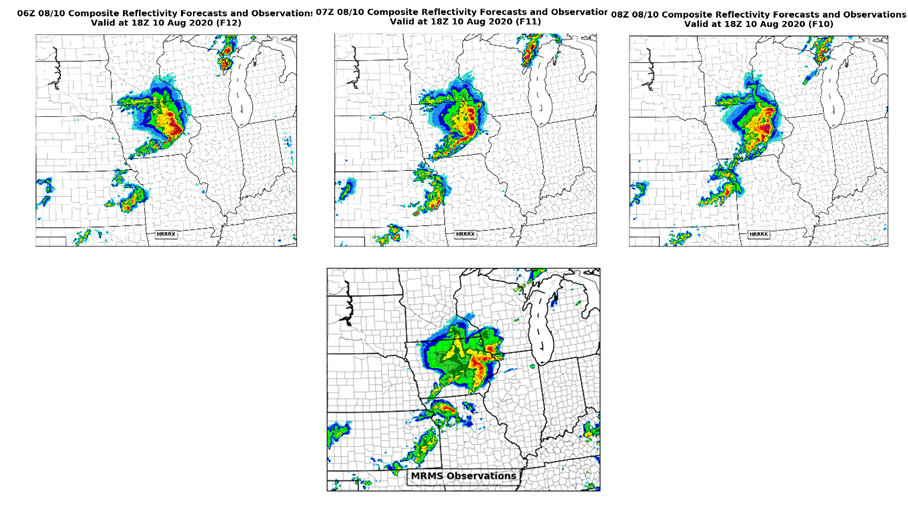High-Resolution Rapid Refresh

Above: Comparison of HRRR composite reflectivity forecasts of the August 2020 Iowa derecho from three forecasts versus the observed reflectivity from the Multi-Radar/Multi-Sensor System (MRMS).

Above: 18-h forecast of HRRR surface smoke (left) and HRRR total colum integrated smoke (right) valid 1800 UTC 15 September 2020.
The High-Resolution Rapid Refresh is a NOAA/NCEP operational
weather prediction system is comprised of a numerical forecast model and an analysis/assimilation system
to initialize the model. It is run with a horizontal resolution of 3 km and has 50 vertical levels.
The HRRR was developed to serve users needing frequently-updated high-resolution short- range weather forecasts, especially those in the US severe weather forecasting community. The model is run over the CONUS every hour of the day; it is integrated to 48 hours for the 00/06/12/18 UTC cycles and to 18 hours for every other cycle. The HRRR Alaska sector is run every third hour; it is integrated to 48 hours for the 00/06/12/18 UTC cycles and to 18 hours for the 03/09/15/21 UTC cycles.
With the December 2020 HRRRv4 upgrade, the CONUS HRRR will begin using a HRRR Data Assimilation System (HRRRDAS), a storm-scale (3km) ensemble data assimilation process in which 36 members are integrated for one hour, and ensemble Kalman Filter data assimilation is performed including direct reflectivity assimilation. The ensemble mean then provides the initial conditions for the HRRR spin-up and analysis process. The Alaska HRRR will continue to use initial conditions from the RAP. The HRRR forecast model is the ARW core of the WRF model, and output is generated every 15 minutes during the forecast for the first 18 hours. Hourly output is generated between forecast hours 18 and 48 for the extended cycles.
The HRRR web site at the NOAA Global Systems Laboratory has hourly displays of all products produced by the system, documentation, and other information.
HRRR History at NCEP:
- HRRRv1 - 30 Sept 2014
- HRRRv2 - 23 Aug 2016
- HRRRv3 - 12 July 2018
- HRRRv4 - 2 December 2020
The December 2, 2020 implementation was the last HRRR upgrade at NCEP. Development is underway on the future Rapid Refresh Forecast System (RRFS), a convection-allowing ensemble forecast system with this projected configuration:
- Based on the limited area FV3 dynamic core
- Rapidly updated and convection-allowing (~3 km grid-spacing)
- Ensemble-based data assimilation
- Ensemble forecast
- 18 h forecast every hour
- 36-60 h forecast every 6 hours
The RRFS is intended to facilitate the replacement of all current mesoscale systems in NCEP Production: NAM/NAM nests, RAP/HRRR, and HiResW/HREF in ~2024.
A chronological listing from 1993-present of all EMC Mesoscale Model upgrades, including all RUC/RAP/HRRR implementations, can be found at the EMC Mesoscale Model reference web site.
Official RAP and HRRR graphics from the operational runs can be found at the NCEP Model Analysis and Guidance (MAG) web site.

Above: Comparison of HRRR composite reflectivity forecasts of the August 2020 Iowa derecho from three forecasts versus the observed reflectivity from the Multi-Radar/Multi-Sensor System (MRMS).

Above: 18-h forecast of HRRR surface smoke (left) and HRRR total colum integrated smoke (right) valid 1800 UTC 15 September 2020.
The High-Resolution Rapid Refresh is a NOAA/NCEP operational weather prediction system is comprised of a numerical forecast model and an analysis/assimilation system to initialize the model. It is run with a horizontal resolution of 3 km and has 50 vertical levels.
The HRRR was developed to serve users needing frequently-updated high-resolution short- range weather forecasts, especially those in the US severe weather forecasting community. The model is run over the CONUS every hour of the day; it is integrated to 48 hours for the 00/06/12/18 UTC cycles and to 18 hours for every other cycle. The HRRR Alaska sector is run every third hour; it is integrated to 48 hours for the 00/06/12/18 UTC cycles and to 18 hours for the 03/09/15/21 UTC cycles.
With the December 2020 HRRRv4 upgrade, the CONUS HRRR will begin using a HRRR Data Assimilation System (HRRRDAS), a storm-scale (3km) ensemble data assimilation process in which 36 members are integrated for one hour, and ensemble Kalman Filter data assimilation is performed including direct reflectivity assimilation. The ensemble mean then provides the initial conditions for the HRRR spin-up and analysis process. The Alaska HRRR will continue to use initial conditions from the RAP. The HRRR forecast model is the ARW core of the WRF model, and output is generated every 15 minutes during the forecast for the first 18 hours. Hourly output is generated between forecast hours 18 and 48 for the extended cycles.
The HRRR web site at the NOAA Global Systems Laboratory has hourly displays of all products produced by the system, documentation, and other information.
HRRR History at NCEP:
- HRRRv1 - 30 Sept 2014
- HRRRv2 - 23 Aug 2016
- HRRRv3 - 12 July 2018
- HRRRv4 - 2 December 2020
The December 2, 2020 implementation was the last HRRR upgrade at NCEP. Development is underway on the future Rapid Refresh Forecast System (RRFS), a convection-allowing ensemble forecast system with this projected configuration:
- Based on the limited area FV3 dynamic core
- Rapidly updated and convection-allowing (~3 km grid-spacing)
- Ensemble-based data assimilation
- Ensemble forecast
- 18 h forecast every hour
- 36-60 h forecast every 6 hours
The RRFS is intended to facilitate the replacement of all current mesoscale systems in NCEP Production: NAM/NAM nests, RAP/HRRR, and HiResW/HREF in ~2024.
A chronological listing from 1993-present of all EMC Mesoscale Model upgrades, including all RUC/RAP/HRRR implementations, can be found at the EMC Mesoscale Model reference web site.
Official RAP and HRRR graphics from the operational runs can be found at the NCEP Model Analysis and Guidance (MAG) web site.